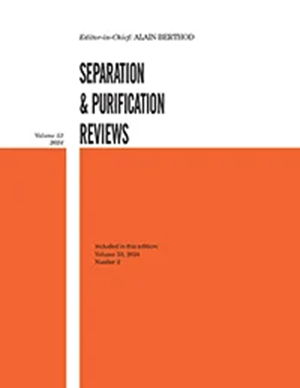Polysaccharide Hydrogels for Controlling the Nutrient Release
IF 5.6
2区 工程技术
Q1 CHEMISTRY, ANALYTICAL
引用次数: 0
Abstract
ABSTRACTNutrient run-off from agriculture causes water pollution and eutrophication. Polysaccharide hydrogels with controlled release of nutrients have been developed to minimize nutrient leaching and run-off. This review compares the loading and release of different nutrients from polysaccharide hydrogels for fertilizing purposes. Urea was encapsulated into polysaccharide hydrogels through blending, adsorption, and coating to minimize fast hydrolysis and possible volatilization. Urea release could be controlled by incorporating inorganic fillers, increasing polymer density, and reducing pore size. Early works incorporated polysaccharides into synthetic polymer hydrogel. Cellulose, cellulose derivatives, starch, chitosan, and alginate were later used as the composite hydrogel in urea encapsulation. The controlled release of other nitrogen sources such as KNO3, NH4NO3, NH4Cl, and leather waste was also studied. Phosphate release was reduced using copolymers containing Arabic gum, carboxymethyl cellulose, and starch-rich waste besides chitosan and carboxymethyl cellulose hydrogels. Potassium release from polysaccharide hydrogel containing nitrogen, phosphorus, and potassium could be electrostatically controlled. Polysaccharide hydrogels containing micronutrients, humic acids, and sucrose were also developed. Most of the polysaccharide hydrogels did not fulfill the nutrient release standards. Besides controlling the release of multiple nutrients, further reduction of cost using polysaccharide-rich waste and nutrients in the wastewater should be considered.KEYWORDS: Polysaccharidehydrogelnutrientcontrol releasefertilizer DISCLOSURE STATEMENTNo potential conflict of interest was reported by the author(s).Additional informationFundingThis work is funded through Engineering X, an international collaboration funded by the Royal Academy of Engineering and Lloyd’s Register Foundation.控制养分释放的多糖水凝胶
农业养分流失造成水体污染和富营养化。为了最大限度地减少养分的淋失和流失,开发了具有养分控释的多糖水凝胶。本文比较了多糖水凝胶中不同营养物质的加载和释放情况。尿素通过混合、吸附和包衣被包裹成多糖水凝胶,以减少快速水解和可能的挥发。尿素的释放可以通过添加无机填料、增加聚合物密度和减小孔隙尺寸来控制。早期的研究将多糖掺入合成聚合物水凝胶中。后来,纤维素、纤维素衍生物、淀粉、壳聚糖和海藻酸盐作为复合水凝胶用于尿素包封。同时还研究了其他氮源如KNO3、NH4NO3、NH4Cl和皮革废弃物的控制释放。除壳聚糖和羧甲基纤维素水凝胶外,还使用含有阿拉伯胶、羧甲基纤维素和富含淀粉的废物的共聚物来减少磷酸盐的释放。含氮、磷、钾的多糖水凝胶可以通过静电控制钾的释放。还开发了含有微量营养素、腐植酸和蔗糖的多糖水凝胶。多数多糖水凝胶不符合营养物质释放标准。除了控制多种营养物质的释放外,还应考虑利用废水中富含多糖的废物和营养物质进一步降低成本。关键词:多糖、水凝胶、营养物、控释剂、肥料披露声明作者未报告潜在利益冲突。本研究由英国皇家工程院和劳氏船级社基金会资助的国际合作项目“工程X”资助。
本文章由计算机程序翻译,如有差异,请以英文原文为准。
求助全文
约1分钟内获得全文
求助全文
来源期刊
CiteScore
12.20
自引率
1.90%
发文量
24
审稿时长
6 months
期刊介绍:
Separation & Purification Reviews provides comprehensive summaries and interdisciplinary viewpoints of significant developments in all areas of separation and purification, including innovative methods, apparatus, theories, and applications. The journal presents reviews that cover a large amount of scientific/technical information in a concise and organized manner on topics such as adsorption, centrifugation, chromatography, crystallization, distillation, extraction, filtration, ion exchange, membrane separations of solid, liquid or gaseous materials.

 求助内容:
求助内容: 应助结果提醒方式:
应助结果提醒方式:


